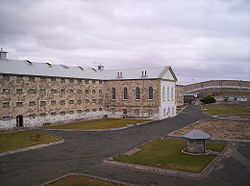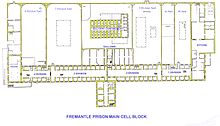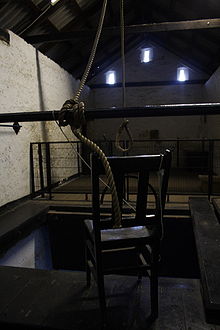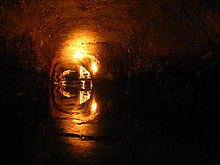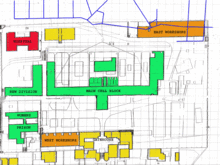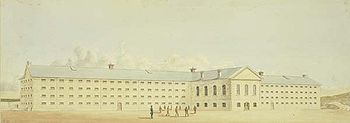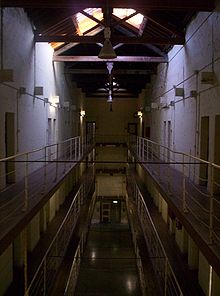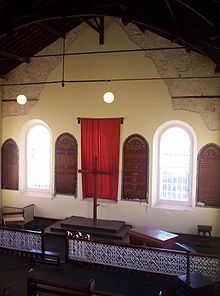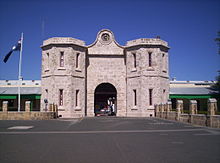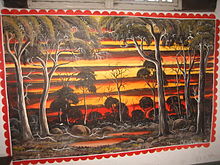- Fremantle Prison
-
Australian Convict Sites * UNESCO World Heritage Site
Fremantle Prison, one of eleven Australian Convict Sites inscribed on the World Heritage ListCountry Australia Type Cultural Criteria iv, vi Reference 1306 Region ** Asia-Pacific Inscription history Inscription 2010 (34th Session) * Name as inscribed on World Heritage List
** Region as classified by UNESCOFremantle Prison Location Fremantle, Western Australia, Australia Coordinates 32°3′18″S 115°45′13″E / 32.055°S 115.75361°ECoordinates: 32°3′18″S 115°45′13″E / 32.055°S 115.75361°E Status Museum, World Heritage Site Security class Maximum Capacity 800 Opened 1855 Closed 8 November 1991 Managed by Government of Western Australia Fremantle Prison is a former Australian prison located in The Terrace, Fremantle, in Western Australia. The 6-hectare (15-acre) site includes the prison, gatehouse, perimeter walls, cottages, tunnels, and prisoner art. The prison was one of 11 former convict sites in Australia inscribed on the World Heritage List in 2010 as the Australian Convict Sites.[1]
The prison was built by convict labour in the 1850s, and transferred to the colonial government in 1886 for use as a gaol for locally-sentenced prisoners. It closed as a prison in 1991 and reopened as a historic site. It is now a public museum, managed by the Government of Western Australia with daily and nightly tours being operated. Some tours include information about the possible existence of ghosts within the prison. There are also tours of the flooded tunnels and aqueducts under the prison.
The prison is also widely referred to as Fremantle Gaol.
Contents
History
Construction
Fremantle Prison was constructed soon after the arrival of the convict ship Scindian in 1850. The Swan River Colony was settled by free settlers in 1829. In 1849, the farmers petitioned the colonial authority to request skilled convicts be sent from the British government. The first ship with 75 prisoners aboard arrived even before confirmation of the request was received. Edmund Henderson found on arrival that the town was unprepared and arranged temporary accommodation for the convicts at the harbour master's warehouse (now the Esplanade Hotel). Under direction from Henderson, James Manning and Henry Wray supervised the construction of the prison using convict labour from limestone quarried on-site. Construction began in 1851 and was completed in 1859. The first prisoners were moved there in 1855.[2] The original design of the main cell block was based upon that of Pentonville Prison in England.[3]
Once construction of the prison's wings, perimeter walls and associated buildings was complete, convicts were often used in chain gangs for other public works in the Fremantle and surrounding Perth area, for example, Perth Town Hall and Fremantle Asylum. During this period the prison was named the Convict Establishment, although known locally and informally as the Limestone Lodge.
In 1868, penal transportation ceased in Western Australia. Numbers of transported convicts gradually declined; the prison came under the control of the colonial government and was renamed Fremantle Prison in 1886. Locally-sentenced male and female prisoners were moved from Perth gaol to the site which became the largest prison in Western Australia. Transportation had already ceased in the other colonies by 1853.[4] The old prison bakery was converted into the women's prison to accommodate this new role. It held up to 60 women until 1970, when the women's section closed and the inmates were transferred to Bandyup Women's Prison, north-east of Perth. The former women's section then became the prisoner assessment centre.
During construction of the buildings, six deep shafts were sunk into the limestone bedrock to the east of the main building to provide the prisoners with fresh water from a limestone aquifer. The quality of the water proved better than that in the town and prisoners were soon pumping, by hand, up to 55 megalitres (12×106 imp gal) of water per year from prison reservoirs to the colony and to ships berthing at the developing port. In 1888 a steam pump was installed to take over the work. In 1896, a series of tunnels or Horizontal Drives were constructed 20 metres under the prison to provide a greater surface area allowing more water to be drawn. The work was carried out using prison labour in poor conditions. The accessible tunnels run for over 1 kilometre; however, by 1910 the tunnels system was no longer needed and was sealed, leaving tools and construction equipment in place. The tunnels became the subject of many urban myths in the local area.
In 1907, after the gold rushes in Western Australia and the rapid population growth in the area, the prison was expanded with the construction of New Division to the north, built by contractors with stone from quarries at Rottnest Island. In the yard of this section, a panopticon was built, influenced by Jeremy Bentham's concept.[3] This area also contains Death Row.
During World War I and World War II, the Australian Army took over part of the prison and used it as a military prison from September 1939 until June 1946. Nearby Rottnest Island was also used to hold prisoners and prisoners-of-war during war time.
The last person to be hanged at Fremantle Prison was serial killer Eric Edgar Cooke, executed in 1964.
On 4 January 1988, with recorded inside temperatures of 52.2 °C (126 °F), a prison riot took place.[5] Seventy prisoners took over four and three divisions, taking 15 officers hostage.[6] The riots led to a large fire damaging three and four divisions causing A$1.8 million of damage.
See also: Fremantle prison riotClosure
Fremantle Prison was decommissioned on 8 November 1991.[7] Prisoners were transferred to Casuarina Prison about 30 km south of Perth, which opened the same year. Casuarina Prison replaced the 130-year-old Fremantle Prison as the state's main maximum-security prison. The buildings remained the jurisdiction of the Department of Housing and Works and the complex was leased for ten years to a conservation group, the Fremantle Guardians, who successfully ran tours around the buildings. After the lease expired in 2001, the state government again took control and embarked on a long-term plan for the future conservation of the site.
The network of tunnels under the prison was opened to the public on 7 June 2005.
Prison operation
Thomas Hill Dixon held the position of Superintendent of Convicts for nine years, running Fremantle Prison and the convict system. Together with the Comptroller General Edmund Henderson, he created a reforming, humane convict system for Western Australia. He instituted a system of training convicts in a trade, and he adapted Western Australia's legal situation to the marks system used by Alexander Maconochie in the Norfolk Island penal system. He was opposed to flogging and favoured the introduction of female convicts into Western Australia.
Cell sizes were increased by knocking down the inner wall between two cells after changes were ordered following a Royal Commission held in the 1890s. At the same time, the prison was divided into several parts. In the main block, four divisions were created:
- One Division—Short sentences, remand prisoners, and (up until 1970) juveniles as young as 13 years old.
- Two Division—Serious crimes without violence.
- Three Division—Violent offenders.
- Four Division—Murderers and long-term men.
The main block also houses solitary confinement, the gallows and two churches.
The gallows room was the only legal place of execution in Western Australia between 1888 and 1965, with 43 men and one woman hanged in this period, the last being Eric Edgar Cooke. Aside from hanging, other punishments for lesser crimes included solitary confinement and lashings in the exercise yard.
Michal Bosworth writes that staff disliked giving the lashings and reports on a remission in lashes ordered in 1853, "because no one could be found to carry out the punishment."[8] However, the last flogging occurred in 1943.
 6th Commandment in the Anglican chapel
6th Commandment in the Anglican chapel
The prison contains two chapels, one Protestant and one Catholic. Behind the Anglican chapel altar, there is a painted representation of the Ten Commandments. The words to the sixth commandment use the unusual translation of "thou shalt do no murder" rather than "thou shalt not kill," the more common interpretation in the Church of England.[9] Given that the gallows were still in regular use, it was felt that "thou shalt not kill" would have been hypocritical. The most notable feature in the church is the face of child-murderer Martha Rendell, which can be seen on the outside of the window but not on the inside.
Restoration and heritage listing
In August 2005, work began on the restoration of the prison gatehouse area. Poor-quality concrete rendering was removed and the original stonework was revealed in October 2005. The work is the start of a three-year plan to halt the deterioration of the buildings and preserve them for the future.
Fremantle Prison is currently the best preserved convict-built prison in the country and became the first building in Western Australia to be listed on the Australian National Heritage List.[10] The Australian Federal Heritage Minister, Senator Ian Campbell, stated that it would be included in a nomination of eleven convict areas to become World Heritage Sites.
Policy dictates the prison is used for the benefit of the community without damaging the fabric of the site. Since 1992, the prison has operated as a heritage museum, and by 2005 the prison was attracting more than 130,000 visitors every year. The Anglican Chapel is currently visited on tours and used for wedding services; New Division is used as a New Business Enterprise Centre; the hospital is now home to the Fremantle Children's Literature Centre; and the women's prison is now an art college.
Guided tours run daily through the site. Torchlight tours are also held twice weekly. Ramps are provided to enable disabled access through the ground floors of the prison; however, some upper levels are inaccessible. On tunnels tours visitors can walk and paddle through the tunnels by boat. Visitors descend 20 metres down a set of vertical ladders attached with harnesses and need to be fairly fit. A gift shop and restaurant also operate. The prison is closed Good Friday and Christmas Day.
Prison art
The prison art gallery, a joint initiative between the Department of Justice and the Department of Housing and Works, showcases and offers for sale the artworks of current and ex-prisoners of Western Australia. Art therapy has been used within the prison for education and rehabilitation.
Additionally many cells and areas of the prison depict prisoners' artwork, including that of the 19th-century forger James Walsh, whose artwork was hidden beneath layers of white-wash for decades. Painting or drawing on walls was originally forbidden, however, this rule was relaxed in special cases where art was found to calm violent prisoners, and was relaxed generally towards the end of the life of the facility.
A more contemporary prison artist was Dennis (NOZ) Nozworthy, who stated that he found art on death row. Some of his work currently is held in the collections of Curtin University, Perth Central TAFE, and the WA Government, Department of Justice.[11]
Other cells contain Aboriginal artwork many by unknown artists. The Walmajarri artist Jimmy Pike started painting in Fremantle prison, having received tuition from Steve Culley and David Wroth.[12]
Prisoners
- Brenden Abbott – "the Postcard Bandit"; escaped the prison on 24 November 1989, by fabricating a prison guard uniform.
- Eric Edgar Cooke - Serial killer, last person to be hanged in Fremantle Prison (26 October 1964).
- Moondyne Joe - Bushranger - Famed escape artist.
- John Boyle O'Reilly - Fenian political prisoner.
- Martha Rendell - Last woman to be hanged at the prison.
- Bon Scott - Former lead singer of rock band AC/DC[13]
- James Wilson - Irish Nationalist.
- John Button - Served 5 years after being wrongfully convicted of manslaughter.
- David Birnie - serial killer
Other notable prisoners include members of the Fenian Brotherhood. Sixty-two Fenian's arrived at Fremantle in 1867. Many were pardoned over the years; however, in 1876 six managed to escape and fled aboard the Catalpa whaleboat to New York.[14]
STM Controversy
In 2010, a writer[who?] for STM (Sunday Times Magazine) claimed[citation needed] that the prison should be demolished because it is a place of suffering. This statement caused a public outcry, with several Fremantle residents sending angry letters to The Sunday Times, stating the exact opposite of what the writer claimed.
See also
- Convict era of Western Australia
- The Hougoumont
- List of allegedly haunted locations
- Round House - Also located in Fremantle, built in 1830, and used as a prison for colonial and indigenous prisoners until 1886.
- Perth Gaol
References
- ^ "World heritage status for Fremantle Prison". Australian Broadcasting Corporation. 1 August 2010. http://www.abc.net.au/news/stories/2010/08/01/2970125.htm. Retrieved 1 August 2010.
- ^ Fremantle Prison, James Semple Kerr, Published by Department of Contract And Management Services. Significance Statement, History and Policy Document. Revised 1998. ISBN 0-7244-9856-7
- ^ a b Things to see in Fremantle Accessed 14 January 2006.
- ^ Fremantle Prison National Heritage Values. Accessed 14 January 2006.
- ^ Commemoration, Voices & Museums Report Accessed 30 April 2006.
- ^ Fremantle Prison, a brief history Cyril Ayris ISBN 0-9581882-1-1
- ^ Fremantle - Western Australia The Age. Retrieved 18 June 2011
- ^ Michal Bosworth (2004). Convict Fremantle: a Place of Promise and Punishment. University of WA Press: Printing Press. (book review) ISBN 1-920694-33-1
- ^ The Hebrew word ratsach, used in this commandment, is close to the word murder; kill is a mistranslation, but it does not translate directly to the word murder. While most uses of the word ratsach are in passages describing murder, in Proverbs 22:13 a lion ratsach a man to death, causing many to believe that since a lion cannot murder anyone, murder is a flawed translation as well. In Joshua 20:3, ratsach is used to describe death by negligence. A closer translation would be to "kill in the manner of a predatory animal." Some Jews take offense at translations which state "thou shall not kill," which they hold to be a flawed interpretation, for there are circumstances in which one is required to kill, such as if killing is the only way to prevent one person from murdering another, or killing in self-defense. See Ten Commandments#Significance of the Decalogue
- ^ WA's first National Heritage listing Accessed 14 January 2006.
- ^ Perth Institute of Contemporary Arts: Dennis (NOZ) Nozworthy Accessed 6 February 2006.
- ^ "Revisiting the Prison: Museums in a Penal Landscape" Dr Sylvia Kleinert, Associate Professor of Australian Indigenous Art (rtf document)
- ^ Bon Scott's grave given heritage listing
- ^ Fremantle Prison Website Entry on The Fenians Accessed 14 January 2006..
External links
- Fremantle Prison official site
- Western Australian Convicts 1850-1868
- Google Maps
- Australian National Heritage Listing for Fremantle Prison
 Prisons in Western AustraliaAcacia Prison · Albany Regional Prison · Bandyup Women's Prison · Banksia Hill Juvenile Detention Centre · Boronia Pre-release Centre for Women · Broome Regional Prison · Bunbury Regional Prison · Casuarina Prison · Eastern Goldfields Regional Prison · Fremantle Prison · Greenough Regional Prison · Hakea Prison · Karnet Prison Farm · Nyandi Women's Prison · Pardelup Prison Farm · Perth Gaol · Rangeview Juvenile Remand Centre · Roebourne Regional Prison · Round House · Wooroloo Prison FarmSee also: List of Australian prisonsCategories:
Prisons in Western AustraliaAcacia Prison · Albany Regional Prison · Bandyup Women's Prison · Banksia Hill Juvenile Detention Centre · Boronia Pre-release Centre for Women · Broome Regional Prison · Bunbury Regional Prison · Casuarina Prison · Eastern Goldfields Regional Prison · Fremantle Prison · Greenough Regional Prison · Hakea Prison · Karnet Prison Farm · Nyandi Women's Prison · Pardelup Prison Farm · Perth Gaol · Rangeview Juvenile Remand Centre · Roebourne Regional Prison · Round House · Wooroloo Prison FarmSee also: List of Australian prisonsCategories:- Buildings and structures completed in 1859
- Visitor attractions in Perth, Western Australia
- Buildings and structures in Perth, Western Australia
- Landmarks in Perth, Western Australia
- Convictism in Western Australia
- Fremantle
- Heritage places of Western Australia
- Prison museums in Australia
- Museums in Western Australia
- Defunct prisons in Western Australia
- 1855 establishments in Australia
- 1991 disestablishments
- Limestone buildings
- Neoclassical architecture in Australia
- Australian Convict Sites
Wikimedia Foundation. 2010.

